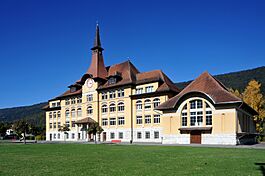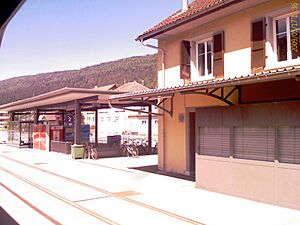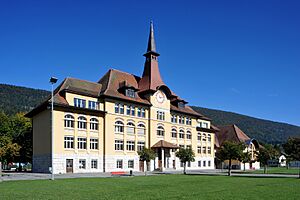Courtelary facts for kids
Quick facts for kids
Courtelary
|
||
|---|---|---|

School house in Courtelary
|
||
|
||
| Country | Switzerland | |
| Canton | Bern | |
| District | Jura bernois | |
| Area | ||
| • Total | 22.21 km2 (8.58 sq mi) | |
| Elevation | 695 m (2,280 ft) | |
| Population
(Dec 2020 )
|
||
| • Total | 1,405 | |
| • Density | 63.26/km2 (163.84/sq mi) | |
| Postal code |
2608
|
|
| Surrounded by | Cormoret, Nods, Cortébert, Mont-Tramelan, Les Breuleux, La Chaux-des-Breuleux | |
Courtelary is a lovely town in Switzerland. It's located in the French-speaking part of the Bernese Jura region, within the Canton of Bern. Courtelary is also the main town, or capital, of the Jura bernois administrative district.
Contents
History of Courtelary
Courtelary was first mentioned way back in the year 968! It was called Curtis Alerici then. This name appeared in a list of properties belonging to an old monastery called Moutier-Grandval Abbey. Later, in 1179, the Pope himself, Pope Alexander III, confirmed that the Abbot (the head of the monastery) owned Courtelary.
Over time, the valley where Courtelary is located came under the control of the Prince-Bishop of Basel. This was a powerful religious leader who also ruled over land. The valley became part of a special area called the Seigniory of Erguel. By the late 1200s, the town of Biel also had some control over this area.
A small church dedicated to Saint Imerius was built in Courtelary around the 10th or 11th century. People believed in the "cult" of Saint Imerius, meaning they greatly admired and followed his teachings. This church was made bigger several times over the centuries. During a renovation in the 1930s, old paintings from the 11th century were found inside!
In 1530, the town of Biel started to make the Erguel region accept the Protestant Reformation. This was a big change in how people practiced Christianity. The people of the valley didn't like this interference, so they teamed up with the town of Solothurn. With Solothurn's help, Courtelary gained more control over its own affairs. In 1606, the main office for the Erguel region moved to Courtelary's New Castle, which later became the town hall.
During the Thirty Years' War in 1639, soldiers attacked Courtelary. They looted the village and burned down some parts of it.
In 1726, the Prince-Bishop of Basel tried to change many local laws and customs. He wanted to rule everything from a central government. This caused riots and protests in the Erguel valley. Courtelary became a center for people who were against the new government. In 1733, a meeting at Courtelary Castle turned into a riot, and the Prince-Bishop's local ruler had to run away.
Later, in 1792 and 1793, the French Revolution inspired people in Courtelary. They formed their own revolutionary assembly and even created a short-lived "Republic of Erguel." In 1797, the French army invaded the Bishop's lands and made Courtelary the capital of a new area called the Canton of Courtelary. After Napoleon was defeated in 1815, the Erguel region became part of the Canton of Bern. Courtelary remained an important capital for different districts over the years.
Courtelary was mostly a farming town until the early 1900s. Farmers grew grain in the valley. In the mountains, Anabaptist sharecroppers (people who farmed land for a share of the crops) raised dairy cows. They made butter and cheese to sell.
In 1874, a railroad was built through Courtelary. This made it cheaper to transport goods. Because of the railroad, a wood pulp factory was built in the town. In 1935, the famous Camille Bloch chocolate factory moved into this old wood pulp building. While other factories for watch parts and machines were built, the chocolate factory became a big part of Courtelary's industry.
Geography of Courtelary
Courtelary covers an area of about 22.24 square kilometers (8.59 square miles). A little over half of this land (51.4%) is used for farming. A large part (43.6%) is covered by forests. The rest of the land is used for buildings and roads (4.5%), or it's rivers and lakes (0.1%).
The town of Courtelary has two main parts. The main village is down in the valley. There are also several individual farms located higher up on the mountains, about 900 meters (2,950 feet) above sea level.
Since 2010, Courtelary has been the capital of the new Jura bernois administrative district.
Coat of Arms
The coat of arms for Courtelary is red. It has a silver stripe going across it from top left to bottom right. On this stripe, there are three green linden leaves pointing downwards.
People of Courtelary (Demographics)
Courtelary has a population of about 1,430 people. About 13.2% of the people living here are from other countries. Over the last 10 years, the population has grown by about 13%.
Most people in Courtelary (about 82.8%) speak French as their main language. German is the second most common language (11.1%), and Italian is third (1.9%).
In 2008, about 48.4% of the population was male and 51.6% was female. Many people who live in Courtelary were born there or in the same canton (region). About 14.4% of the people were born outside of Switzerland.
Young people (ages 0-19) make up about 24.9% of the population. Adults (ages 20-64) are 56.3%, and seniors (over 64) are 18.8%.
Religion
In 2000, about 23.9% of the people in Courtelary were Roman Catholic. About 56.8% belonged to the Swiss Reformed Church, which is a Protestant church. There were also smaller groups of people who belonged to other Christian churches, Islam, Buddhism, or Hinduism. About 8.16% of the population did not belong to any church.
Weather
Courtelary gets rain or snow on about 145.6 days each year. On average, it receives about 1317 millimeters (51.9 inches) of precipitation. The wettest month is June, with about 126 millimeters (5 inches) of rain or snow. The driest month is September.
Education
In Courtelary, about 33.5% of the people have finished high school (upper secondary education). About 10.2% have gone on to higher education, like university.
The school system in the Canton of Bern starts with two years of kindergarten. Then, students go to six years of primary school. After that, they have three years of lower secondary school. In secondary school, students are grouped based on their abilities. After lower secondary school, students can continue their studies or start an apprenticeship (learning a trade on the job).
During the 2010-2011 school year, 204 students attended classes in Courtelary. There was one kindergarten class with 22 students. There were three primary classes with 61 students, and five lower secondary classes with 90 students. Some of these students were from other countries or spoke a different language at home.
Transportation
Courtelary has its own train station, called Courtelary. It's on the line that connects Biel/Bienne and La Chaux-de-Fonds. Trains run every half hour, making it easy to travel to these nearby cities.
Industry
Courtelary is well-known for the Camille Bloch chocolate factory. It's a famous company that makes delicious chocolates!
Famous Residents
- Paul Miche - a composer
- Eugenio Santoro - a sculptor
See also
 In Spanish: Courtelary para niños
In Spanish: Courtelary para niños







